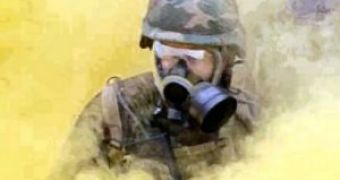Mustard gas is a member of the sulfur mustards, which are a class of chemical warfare agents that in their pure state while at room temperature are colorless, odorless, viscous liquids. When used as a warfare agent, mustard gas has a yellow-brown color resembling that of mustard plants, thus the name. It was first developed and used as a warfare weapon during World War I by the German Empire against enemy troops.
Chemical gases can represent any solid, liquid or gaseous agent that can be classified into one of the three following medical groups: lethal gases, harassing agents and accidental gases. Lethal gases are defined as chemical agents that can inflict disablement or death; harassing agents determine only enemy disruptions while accidental gases are agents that result during the war, but have no direct link to chemical weapons.
Mustard gas is part of the first class of chemical gases. It can be found either in solid, liquid or vapor form and produces large blisters on the skin following contact, damaging both the skin and internal areas of the body. Since it is classified as an alkylating agent, mustard gas also has the ability to alter DNA, which in turn triggers the liquefaction of living tissue.
Basically, mustard gas is a chemical compound with the chemical formula C4H8Cl2S, resembling motor oil and with a freezing temperature of 14 degrees Celsius, meaning it's not very effective during the cold season.
Effects
The effects of a mustard attack are not immediate, meaning that you might feel fine for up to a day before red spots and finally painful blisters form on the body. If inhaled, mustard gas triggers the swelling of the airwaves. The gravity of the effects is directly related to the exposure time and the symptoms include eye irritation, redness, burning, inflammation and blindness, the blistering of the skin, bloody nose, sneezing, hoarse throat, shortness of breath, coughing, sinus pain, abdominal pain, diarrhea, fever, nausea and vomiting.
Mustard gas can also be lethal depending on the degree and duration of exposure. The primary cause of fatality is the onset of broncho-pneumonia, which can kill as much as 50 percent of the people exposed to mustard gas. Most people die within three or four days, while in other cases it may take up to a month. Still, the best method of protection against mustard gas attacks is early detection and the use of gas masks that protect the face and the respiratory system, although the rest of the body is still exposed.

 14 DAY TRIAL //
14 DAY TRIAL //